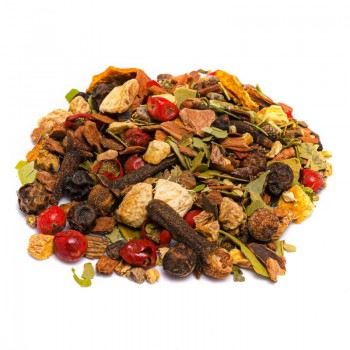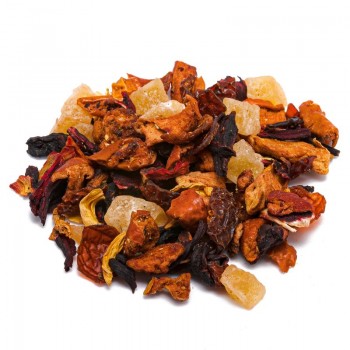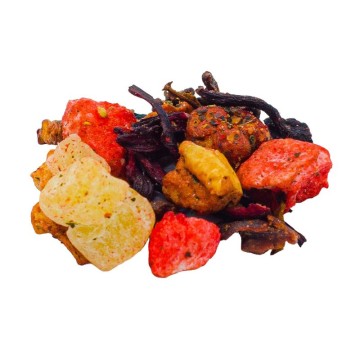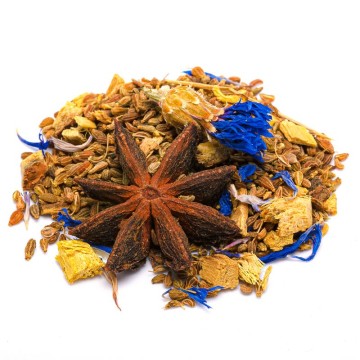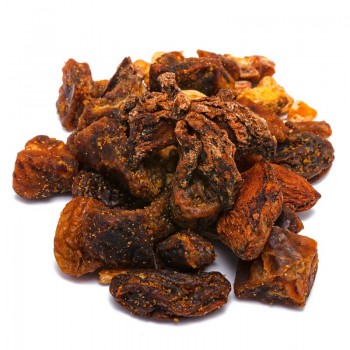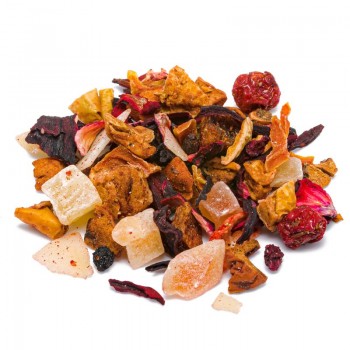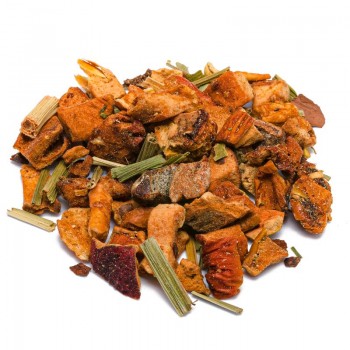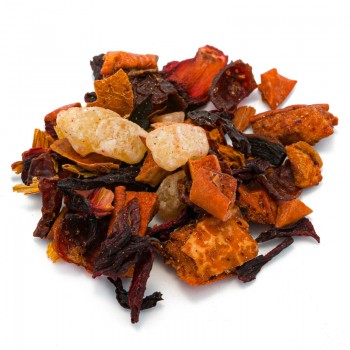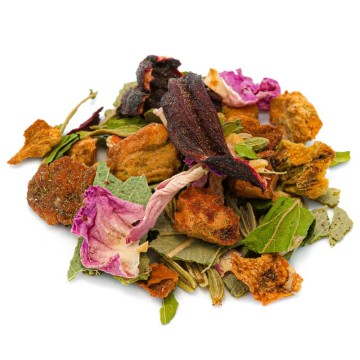This organic infusion of raspberry and goji berries is truly delicious, and thanks to its citrus-based elements, it becomes an infusion with lime-flavoured notes. It is a blend with spring notes, useful in winter to remember the sweetest aromas and regenerate us. Among its ingredients, it is also composed of apple, quince, coconut and flowers with beneficial properties such as cornflower and hibiscus. This infusion is popular for its many nuances of flavor, with a balanced sensation of freshness and sweetness at the same time. Lemon, lemongrass and raspberries provide a slightly acidic taste, balanced by fruits such as apple and coconut. Goji berries combine perfectly with raspberry, providing a delicate result to the drink. The infusion can be enjoyed all year round, even if during cold climates it gives the best of its fruity taste and aroma. Excellent at any time of the day, in the morning it gives a particular boost to our body. The infusion mixture is also appreciated by children for its delicate and pleasant taste, and can also be drunk cold, without losing its goodness.
Raspberry, lime and goji berry infusion: properties and benefits
The elements that make up this mixture are excellent for providing nutrients to the body. The union of raspberry and lemon provides various properties that counteract irritation of the respiratory tract and contribute to strengthening the immune system, also with the contribution of hibiscus (vitamin C). For this reason, the drink in winter can be a useful warmer to prevent colds and keep the respiratory system free. The antioxidant properties of raspberries, given that they also contain quercetin and anthocyanins, help protect and soothe the mucous membranes of our tissues.
All the ingredients contain useful antioxidants, and the virtues of goji berries in this regard are particularly well known. These berries are highly valued for stimulating the metabolism, as energizers. Furthermore, by taking this infusion, you also take the precious nutrients of organic goji berries, from organic cultivation. Among the advantages of the so-called "goji berry tea" there are not only antioxidants and metabolism balance, but also a contribution that increases the body's energy levels. Berries are a good source of vitamins A and C, which help strengthen the immune system along with raspberry, lemon and hibiscus.
The flavonoids and phytonutrients released during the infusion can benefit the body in various ways, for general well-being, helping to protect the circulatory system.
The apple and quince present in the mixture provide nutrients to aid digestion, aided by lemon with detox properties and raspberries – together they promote the elimination of toxins through transit digestive system and diuresis.
Origins and history of cultivation
The herbal tea blend features various natural elements, among which we will especially take into consideration goji berries and raspberries.
The healing properties of Goji berries have been known for millennia in China, where they were harvested from the Lycium barbarum plant. There is an ancient medical book "Treatise of herbs and their properties", in which the virtues of the Goji plant and berries are exalted: they replenish body fluids, calm, revitalize the skin and strengthen eyesight. In other Chinese texts, Goji is referred to as a berry that strengthens muscles and tendons, protects against disease and provides the healthy foundation for a long life.
The fruits were used to prepare a beauty tea and by men to strengthen vitality and physical vigor. These properties of historical Chinese medicine have found some confirmation in modern research, since Goji berries have been appreciated all over the world.
From their Asian origin (although some species of the plant are found in North America), they have also spread to Western tables for a few decades. Their flavor can be compared to that of cranberries, and they are not considered sweet berries. The plant is part of the tomato family, and in fact the juice of the berries has a flavor similar to that of the tomato, a pleasant sourness.
Today, most Goji berries are grown in northwestern China, Inner Mongolia and Tibet.
The red raspberry plant, Rubus idaeus, has been cultivated in Europe for centuries, growing atthe wild state from the Mediterranean to the Baltic and beyond. It is probably native to Turkey, a berry shrub already known to the populations who inhabited Troy. The Romans spread the raspberry seed throughout their empire, and the English already at that time began to cultivate raspberry vines and bushes – it grows as an upright bramble or climbing tree. The plant was also exported to America, where several raspberry hybrids were created.
The fruit has always been appreciated for its flavor, and because it represents a source of nutrients. Even today, jams, ice creams, jellies and juices are made from raspberries - as well as being consumed fresh or dehydrated for infusion. Today, world raspberry production is concentrated in Eastern Europe and Russia, the main producer.
Fruits and flowers
The components of the infusion are many, and the mixture contains leaves and flowers of different origins. Goji berries belong to the Lycium barbarum plant, of the Solanaceae family - related to tomatoes and aubergines. It is native to the tropical or warm regions of eastern Asia. If pruned, the plants are generally 1-2 meter tall shrubs, but if left wild they can reach around 4 metres. The shape of the plant varies significantly between cultivars, it can be vineyard or erect. Thorns are present in most cultivars, and solitary purple flowers form. The small orange or red fruits are also called wolfberries.
Raspberries belong to the Rosaceae family and the most cultivated variety belongs to the Rubus idaeus L. species (also known as red raspberries or European raspberries). They are perennial shrubs that reach about 2 meters in height, with woody, erect stems, equipped with thin, protruding branches. They show thorns and white flowers. The fruits are aggregates of different berries (drupes) and show a not bright red color and a soft consistency. Red raspberries are the most resistant and most cultivated compared to black raspberries.
The quince is known by the scientific name of Cydonia oblonga, belonging to the rose family (Rosaceae). Quinces grow on small trees, with fragrant flowers. The fruit, similar to apples and pears, has a firmer consistency and spongy pulp.
The Malus domestica plant of the Rosaceae family gives apples. It is a tree native to Asia, now widespread throughout the planet. The fruits vary in color and in many varieties, and have been used in our diet for millennia.
The coconut is the edible fruit of the coconut palm tree (Cocos nucifera), of the palm family (Arecaceae). Coconut palms are probably native to Indo-Malaysia, and have a thin and smooth trunk, a crown of leaves and rounded green or yellow fruits. From a botanical point of view, the coconut is a drupe, that is, a fleshy fruit with a hard stone containing the seed; it is not a real nut.
Commonly called lemongrass, the plant is also known as Cymbopogon nardus. It belongs to the Poaceae family, and is a cross between a scented geranium and lemon grass. Native to southern Asia, it has very long, intense green leaves. It grows up to approximately 2 meters, and is also used for the production of lemongrass oil.
Hibiscus comes from the flowering plant Hibiscus sabdariffa, native to India and Malaysia. There are hundreds of types of hibiscus, and the sabdariffa variety is grown as a shrub for its large pink and red flowers. Both the flowers and the leaves and stems are used for various cosmetic and medicinal preparations. Hibiscus tea is obtained from the flowers.
The cornflower (Centaurea cyanus) derives from an annual herbaceous plant of the Asteraceae family. Native to Europe, it was commonly used for fresh or dried flowers in bouquets. The plants are 30 to 90 cm tall, with grey-green leaves and blue, pink or white radial flowers.
The lemon comes from the Citrus ×limon plant, a small tree or bush of the Rutaceae family. The fruit with its characteristic astringent flavor is known throughout the world. The lemon is a hybrid species, which can reach approximately 3-6 meters in height. The flowers have a sweet smell and the fruit shows a yellow outer rind, quite thick in some varieties.
Nutritional values of the infusion of raspberries, lime and goji berries The main active ingredients of this mixture are the antioxidants and the vitamins provided. The nutritional value of the infusion includes vitamins A and C (as well as traces of group B9 vitamins; essential amino acids, minerals (iron, phosphorus, potassium). Antioxidants such as anthocyanins and polyphenols are present in the mixture. How to use the ingredients in the infusion The infusion is obtained by inserting approximately 3-5 grams of the mixture of raspberries, lime and organic goji berries into a cup (250 ml). The water must be at the ideal temperature of 100 °C. Leave to infuse for 10 to 12 minutes, before drinking: the time in which all the ingredients release their benefits. Add honey or sugar, if desired. Raspberry, lime and goji berry infusion: side effects and contraindications It is necessary to respect the recommended doses and not exceed consumption of the infusion for too long periods. Excessive intake of the infusion mixture can cause constipation, nausea and headaches. Furthermore, Goji berries can interact with some blood thinning, diabetes or blood pressure medications ; for this reason, it is useful to talk to your doctor before adding goji berries to your diet on a constant basis. Caution is advised for pregnant or breastfeeding women.

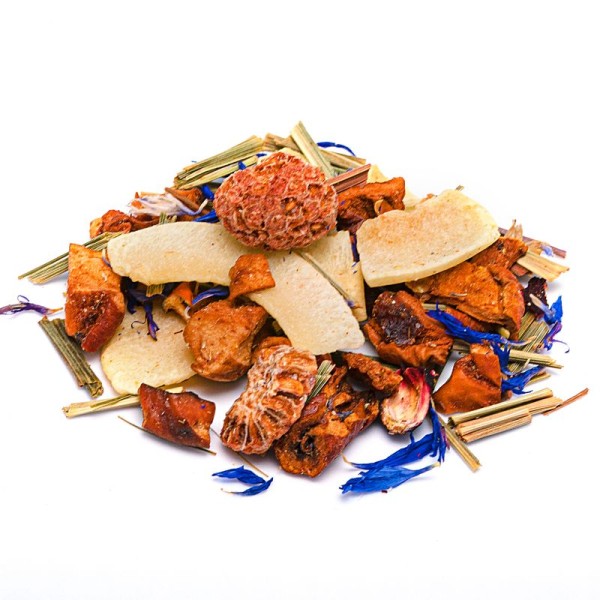









 No reward points for this product.
No reward points for this product.
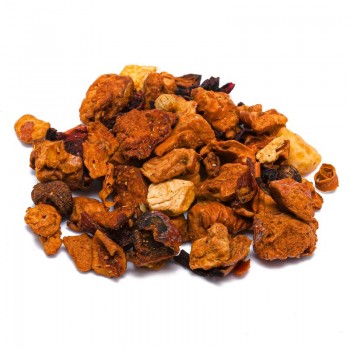
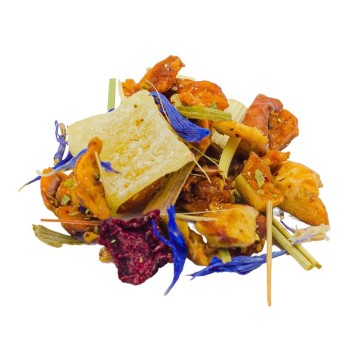
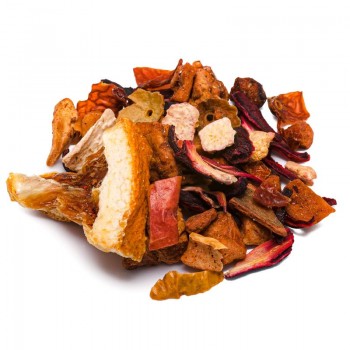

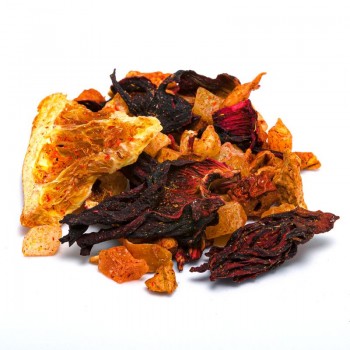
![infuso relax [Natura d'Oriente]](https://www.naturadoriente.com/3555-home_default/infused-relaxation.jpg)
